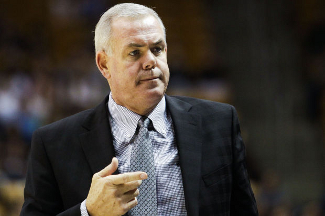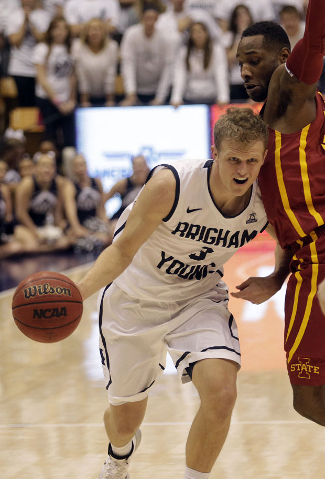CBE Hall of Fame Classic Semifinals Sprint Center | Kansas City, MO | Tip: 6:30 P.M. CT | TV: ESPNU LRT Consecutive Game #259 For the first time since 2010, the Texas Longhorns have started the season with a 4-0 mark. With the exception of last Monday’s win over Houston Baptist, the victories have come against solid mid-major foes, but they have all required second-half comebacks. Tonight, the young Horns will take a big step up in competition when they face BYU at the CBE Hall of Fame Classic in Kansas City. The Cougars are coming off of a narrow, two-point loss in an exciting home game against Iowa State on Wednesday. Although that was a missed opportunity for an excellent résumé-building win, the Cougars did secure a road victory over Stanford in a 112-103 track meet that was part of ESPN’s 24-hour hoops marathon.
Dave Rose is ready to get back to the NCAA tournament BYU missed the NCAA tournament last year after making the dance in six straight seasons, and this year’s tough non-con slate is a clear indication that they intend to return. In addition to the road trip to Stanford, the Cougars face Texas, travel to Oregon and to Springfield, MA for a “neutral” game against UMass, plus will take on either DePaul or Wichita State tomorrow night. The Longhorns looked much better than expected in their first four games, but tonight will provide an opportunity to see just how they match up against solid competition. Although BYU plays in the West Coast Conference that drops off significantly after Gonzaga and Saint Mary’s, they were a mainstay at the top of a tough Mountain West Conference up until their departure in the summer of 2011. A win over this team would quickly raise expectations for this Texas team, but a lot could still be learned in a loss. If Texas goes down tonight, the way that they lose would still speak volumes about the young team’s future. By the numbers Texas has been pushing the tempo so far this season, but the Horns have nothing on BYU. The Cougars are currently the quickest team in the nation in terms of adjusted tempo, averaging more than 80.4 possessions per game. With both teams loving to run, fans should be treated to an exciting, up-tempo affair. If you take a quick glance at the numbers, that high-tempo approach might come as a surprise when you look at BYU’s defensive turnover numbers. The Cougars only force miscues on 14.8% of their opponents’ possessions, a rate that is actually one of the 50 lowest in D-I hoops. While many up-tempo teams rely on turnovers and fast breaks to rack up the possessions and the points, BYU breaks the mold. However, the Cougars fuel their up-tempo approach with a suffocating presence on the defensive glass. When you watch BYU close out a defensive possession, it looks like a wave of white jerseys crash into the lane as soon as the shot gets in the air. As a result, the Cougars are limiting opponents to just 25.6% of their offensive rebounding opportunities, and they immediately look up the court once they’ve snagged those defensive boards. On the other side of the ball, BYU has done a phenomenal job limiting their own mistakes. Last year, the team only coughed it up on 17% of their possessions, a mark that ranked them in the top 25 nationally. This season, they’ve reduced that number even more, ending possessions with a turnover only 11.5% of the time. That’s good enough for third in the country, and when combined with their excellent shooters, it leads to a scorching adjusted offensive efficiency of 1.135 points per possession according to Ken Pomeroy. Meet the Cougars Even with the team posting such great turnover numbers, it was sometimes maddening to watch point guard Matt Carlino (No. 2) last season. He often erased a great hustle play with a frustrating mistake, typically a result of forcing things instead of slowing down and setting up the offense. On the season, Carlino’s turnover rate was 22%, but he has already slashed that to just 14.3% this year. The Cougars don’t take a ton of three pointers, with less than 18% of their attempts coming from beyond the arc. The team is generally very accurate when they try a triple, though, hitting more than 41% of their attempts. Carlino is bucking that trend in both of those areas this year, taking closer to 30% of his shots from long range and hitting only 20% of them so far. However, Texas can’t simply sag off to take away his driving ability, as Carlino proved last season to be a streaky long-range shooter who can get hot in a hurry. Joining Carlino in the backcourt is Kyle Collinsworth (No. 5), a sophomore guard who has returned to the team after his two-year mission trip to Russia. Collinsworth is going to be a tough matchup for a Texas team that typically plays three guards under 6’2″. He’s a strong 6’6″ guard who is crafty with the ball and is skilled at shifting speeds to get to the rim. He can muscle through contact to get his shot up and earn trips to the line, and that added length is also a big reason for the team’s success on the glass. Like Collinsworth, Tyler Haws (No. 3) is a big guard who will create matchup issues for Texas. He’s a player who can score in a variety of ways, and his midrange game is pristine. Haws has a quick release and loves to hit jumpers around the elbow when he catches passes coming off of curls. Haws has missed two games due to injury this year, but has poured it on when he’s seen the court, averaging more than 26 points per game.
BYU needs Eric Mika to emerge as a post presence Haws can use his strength to get to the rim and his speed often gets defenders on his hip. As a result, he’s constantly earning free throws, and this year he has reaped the benefits of the new emphasis on whistling defensive contact. Last season, he already drew an impressive 5.4 fouls per 40 minutes, which ranked him 155th nationally. This year, he has ascended to the 29th slot, drawing 8.7 whistles per 40 minutes. The biggest loss for BYU this offseason was that of big man Brandon Davies. Coach Dave Rose is confident that freshman Eric Mika (No. 00) will serve as an excellent replacement, and so far he has been proven correct. Like Davies, Mika is a fantastic passer, and he often pulls opposing bigs up the paint to open up cutting lanes for Haws. While Mika has a long way to go in order to match Davies’ 17.5% assist ratio from last year, he has certainly shown the ability to make crisp passes from the high post. The other forward for the Cougars is Nate Austin (No. 33), who has had a quiet statistical start to the season. Although he’s averaging just a little more than five points per game, the 6’11” junior has a nice midrange jumper and has shown range out to the arc. He has been highly efficient with his shots so far this season, knocking down 12 of 16, with two of those misses from three-point land. One man who is expected to light it up from that long range is JUCO transfer Skyler Halford (No. 23). He was a deadeye shooter for Salt Lake CC, but he has struggled so far at the D-I level. Halford is just 2-for-9 on threes so far this season, but is still a very dangerous shooter that Texas must blanket. Junior Anson Winder (No. 20) has earned the most minutes of the reserves so far, mostly as a result of sliding into the starting five during Haws’ absence. He’s battled injuries of his own throughout his BYU career, but will provide some key depth for a team that plays at breakneck speed. Freshman Frank Bartley IV (No. 24) is another guard off the bench for Coach Rose, and he’s shown some promise through his first five games. Like all of the BYU guards, he has good driving ability along with strength and body control. He’s shooting over 63% from the floor thanks to his ability to beat the defense on the bounce, and should be a big part of BYU’s plans in the future. The final player who has seen action in every game is freshman Luke Worthington (No. 41), who is another option down low for BYU. A Wisconsin native, Worthington was recruited by his home-state Badgers to play football, and he brings that physical nature to the floor for his limited minutes. He’s still raw and lacks some touch near the rim, but he’s a serviceable reserve option for the Cougars when Mika and Austin need a breather. Keys to the game 1) Slow down the transition game – Texas will have its hands full trying to slow down the Cougars tonight, but that will be vital if the Horns want to pull off an upset. Although the Cougars don’t force many turnovers, the Longhorns have had their share of unforced errors this season. They must avoid live-ball turnovers that fuel the BYU break, and they will likely need to have a guard or two drop back once shots go up to avoid giving up transition points after their own misses.
Texas will have a hard time containing Haws 2) Attack with the dribble – The Cougars prefer to play man-to-man defense, and the Longhorns struggle against zones. It’s a match made in heaven as far as Texas fans are concerned, as long as the Texas guards play aggressively and attack off the bounce. Coach Rose is not completely allergic to the zone and has used it in the past, but he probably will ride with the man until Texas forces him to change. When teams don’t attack the BYU man, they typically have to settle for jumpers, and the Cougars make sure that they don’t allow many second chances. If Texas wants to hang with BYU tonight, the Horns have to avoid falling into that trap. 3) Stay glued to Haws – It’s going to be hard to keep Haws off of the scoresheet, but the Longhorns have to limit his damage. His driving ability means that help defense will be a must, and the team must also keep an eye on him whe he’s off the ball. Haws moves very well without the basketball and doesn’t need much space to get off a shot. The Longhorns have had issues giving up wide-open looks so far this season when they rotate a little too late or close out too slowly. Doing that against Haws — and really any of BYU’s excellent shooters — would be a recipe for disaster tonight. |











